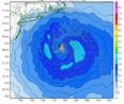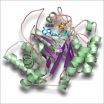(Press-News.org) Heart rate recovery at one minute after a six-minute walking distance (6MWD) test is highly predictive of clinical worsening and time to clinical worsening in patients with idiopathic pulmonary arterial hypertension (IPAH), according to a new study.
"Ours is the first study to show that heart rate recovery at one minute of rest (HRR1) following a 6MW test is a strong predictor of clinical worsening in IPAH patients," said Omar A. Minai, MD, staff physician in the Department of Pulmonary, Allergy, and Critical Care Medicine at the Cleveland Clinic. "Predicting long-term prognosis in these patients usually requires analysis of several pieces of data in complicated risk scores. This easily measured, cost-free biomarker may ultimately advance patient care in view of its ability to accurately predict clinical worsening even in patients receiving treatment for pulmonary hypertension."
The findings were published online ahead of print publication in the American Thoracic Society's American Journal of Respiratory and Critical Care Medicine.
The study enrolled 75 patients with a diagnosis of IPAH, confirmed by right heart catheterization. Heart rate was recorded at the end of the 6MW test and then one minute after completing the test. Clinical worsening was defined as any of the end points of death, lung transplantation, hospitalization for worsening PH, or escalation of PH therapy. The cutoff value for abnormal HRR at one minute following the 6MW test was identified as 16 beats. A greater reduction in heart rate after exercise indicates a better-conditioned heart.
"Patients with HRR1 END
Heart rate recovery predicts clinical worsening in pulmonary hypertension
2011-11-21
ELSE PRESS RELEASES FROM THIS DATE:
Metabolic syndrome biomarkers predict lung function impairment after exposure to WTC dust
2011-11-21
Metabolic syndrome biomarkers predict subsequent decline in lung function after particulate exposure, according to new research involving rescue personnel exposed to World Trade Center (WTC) dust.
In a nested case-control study of 327 non-smoking FDNY 9/11 rescue workers, metabolic syndrome biomarkers measured within six months of exposure to WTC dust predicted decline of forced expiratory volume in one second (FEV1) over the next six years.
"Study participants with dyslipidemia, elevated heart rate or elevated leptin levels had a significantly increased risk of developing ...
As probiotics use grows for gut health, VSL#3 has designations for specific GI issues
2011-11-21
GAITHERSBERG, MD, Nov. 18 – As clinical studies continue to validate the use of probiotics to help promote general gastrointestinal health, a growing U.S. market1 for probiotics indicates that the U.S. healthcare community and consumers alike are recognizing the value of these beneficial microorganisms. However, because most probiotics are classified as dietary supplements, directing patients to the best probiotic for their individual needs can be challenging. And, as the category matures, one probiotic preparation -- VSL#3 -- stands apart and ahead because it is not a ...
The protest vote prevails when a landslide victory is expected
2011-11-21
Researchers at the Juan March foundation and the Duke University (USA) have analysed the reason for casting a protest vote as a way of expressing unhappiness with a party during elections. Moderate voters are more likely to vote in this way than those at the extreme left or extreme right of the political spectrum.
Daniel Kselman, researcher at the Juan March Foundation and co-author of the study that analyses such behaviour states that "the protest vote is just a way of expressing discontent. In order for it to be effective, a lot more voters from your party need to vote ...
NRL Monterey develops more accurate tropical cyclone prediction model
2011-11-21
WASHINGTON -- Researchers at the Naval Research Laboratory (NRL) Marine Meteorology Division (MMD), Monterey, Calif., have developed the Coupled Ocean/Atmosphere Mesoscale Prediction System Tropical Cyclone (COAMPS-TC™) model, achieving a significant research milestone in predictions of tropical cyclone intensity and structure.
While the predictions of the paths or tracks of hurricanes, more generally referred to as tropical cyclones (TC), have steadily improved over the last few decades, improvements in the predictions of storm intensity have proven much more difficult.
"Over ...
Protection from severe malaria explained
2011-11-21
Why do people with a hereditary mutation of the red blood pigment hemoglobin (as is the case with sickle-cell anemia prevalent in Africa) not contract severe malaria? Scientists in the group headed by Prof. Michael Lanzer of the Department of Infectious Diseases at Heidelberg University Hospital have now solved this mystery. A degradation product of the altered hemoglobin provides protection from severe malaria. Within the red blood cells infected by the malaria parasite, it blocks the establishment of a trafficking system used by the parasite's special adhesive proteins ...
Chalmers scientists create light from vacuum
2011-11-21
Scientists at Chalmers University of Technology have succeeded in creating light from vacuum – observing an effect first predicted over 40 years ago. The results is published tomorrow (Wednesday) in the journal Nature. In an innovative experiment, the scientists have managed to capture some of the photons that are constantly appearing and disappearing in the vacuum.
The experiment is based on one of the most counterintuitive, yet, one of the most important principles in quantum mechanics: that vacuum is by no means empty nothingness. In fact, the vacuum is full of various ...
Enzymatic synthesis of pyrrolysine, the mysterious 22nd amino acid
2011-11-21
This press release is available in German.
With few exceptions, all known proteins are built up from only twenty amino acids. 25 years ago scientists discovered a 21st amino acid, selenocysteine and ten years ago a 22nd, the pyrrolysine. However, how the cell produces the unusual building block remained a mystery. Now researchers at the Technische Universitaet Muenchen have elucidated the structure of an important enzyme in the production of pyrrolysine. The scientific journal Angewandte Chemie reports on their results in its "Early View" online section.
Proteins ...
MU researchers develop tool that saves time, eliminates mistakes in diabetes care
2011-11-21
COLUMBIA, Mo. – In the fast-paced world of health care, doctors are often pressed for time during patient visits. Researchers at the University of Missouri developed a tool that allows doctors to view electronic information about patients' health conditions related to diabetes on a single computer screen. A new study shows that this tool, the diabetes dashboard, saves time, improves accuracy and enhances patient care.
The diabetes dashboard provides information about patients' vital signs, health conditions, current medications, and laboratory tests that may need to be ...
Colon cancer screening campaign erases racial, gender gaps in use of colonoscopy
2011-11-21
Since the 1970s, U.S. mortality rates due to colorectal cancer have declined overall, yet among blacks and Hispanics, the death rates rose. Evidence suggests that underuse of colonoscopy screening among these groups is one reason for the large disparities. In 2003, New York City launched a multifaceted campaign to improve colonoscopy rates among racial and ethnic minorities and women. A new study conducted by researchers at Columbia University's Mailman School of Public Health and the NYC Department of Health and Mental Hygiene demonstrates the notable success of the campaign. ...
A corny turn for biofuels from switchgrass
2011-11-21
Many experts believe that advanced biofuels made from cellulosic biomass are the most promising alternative to petroleum-based liquid fuels for a renewable, clean, green, domestic source of transportation energy. Nature, however, does not make it easy. Unlike the starch sugars in grains, the complex polysaccharides in the cellulose of plant cell walls are locked within a tough woody material called lignin. For advanced biofuels to be economically competitive, scientists must find inexpensive ways to release these polysaccharides from their bindings and reduce them to fermentable ...






